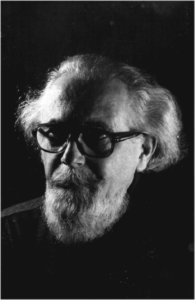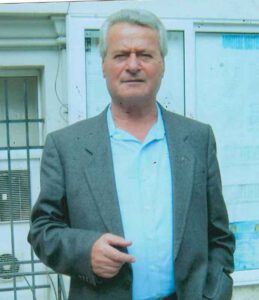Ervin Ditrói Israeli Daily Newspaper in Hungarian, 1990 There are...
Read MoreGideon Ofrat

Kovacs and Delilah
Kovacs calls them “figures” and “human beings”, but we see women _ almost solely women.
Heavy black outlines define their round breasts, as do the organic and wave-like stream of curves, which flow and intertwine one figure with the other. With this linear cord, Kovacs binds his women together into one cluster of Eros. One second glance, we note that his inanimate objects – bottles, fruit, flowers – also stem from the erotic world.
Kovacs endeavors to fix the erotic firmly in its place, the contour is merely a stage in the painting
process which finally ends in turning the woman into a sculpture of stone; interring the living and
dynamic in the timeless and eternal stillness. There are suggestions in the work of this painter who studied sculpture (in the course of 14 years of art studies in Romania), of the monumental
sculpturesque women of Maillol, Henry Moore and others: the Goddess-Woman.
Kovacs’ paintings, however, are a battlefield. Opposed to the reverential leanings toward the large
woman in the tendency to conquer womanhood, as seen in the breaking of the statue and the
demolition of the goddess.
The dynamic is struggling with the static, the vital with the permanent. Note the absence of features in the faces, the severed limbs, the synthetic flattening of the disjointed parts, and even the expressive freedom of the lyrical abstraction of scribbled Panda strokes and the gouache areas. As a result of all this, the unity of the work is undermined, its three-dimensional character denied, replaced by Kovacs’ own form of Modernism, a Modernism which is contemporary with surrealist abstraction and a leaning towards the forms of Jean Arp. At times one sees associations with Marcel Jancu (from his Romanian period), while there are also hints of the Surrealist Picasso in Kovacs’ women. At any rate, Modernist Paris (with its immense influence on the Romanian academies where the artist studied), attacks the feminine unity at the core of the work.
The American De Kooning dealt with this in one manner – Kovacs in his own fashion. In attempting to define his artistic world, Kovacs writes about the dualism in his search of the unknown (which is also the invisible) and the construction of an independent and self-sufficient plastic unity – the romantic dualism of Modernism. One could carry this dualism further by referring here to Kovacs’ paintings as Classicism and Modernism in a dialectical struggle between mythic femininity and self-realization.
The struggle proceeds as follows: the bi-dimensional surface which fractures
the sculptural three-dimensional character, expresses the conquest and submission over the female body. The feminine unity is dealt with simultaneously in various media: pastel, charcoal, watercolors, gouache and collage. On the other hand, however, the manifold media is subdued by soft and light monochromatic unity. Dialectic painting. Creative freedom versus immobility.
I see these paintings as the dialectical tension between erotic fantasy and cultural refinement. The tendency to assemble women in groups, which is also the tendency to position them in a
comparatively figurative manner, is opposed to the inclination to disintegration, to the flattering of the surface and the abstract self-liberation of line and brush. Even the dualism of the linear and
architectural structure (in thin charcoal), which lends the organic-sensual flatness a certain imaginary volume, is also part of the erotic tension present in corporeality and its conquest. In every direction.
Kovacs’ paintings reflect the refusal to repress passion and at the same time, its sublimation and
exaltation. And all this on small sheets of paper which turn into the secret diary of Arp Kovacs, a diary in which every day (each page) bears evidence of further troubling passion. Note the photo collage of the figure of a woman; the collage is completely torn, dissevered taken possession of, by a regressive outburst of sharp lines and at the same time, in the same work, the taming and soothing of the tension via a geometric framework (in green gouache). Or the mythological figure – Lucretia – from a photograph of Titian’s painting, who emerges as a collage from the groins and legs of some lascivious woman in network stockings. As if Samson’s falling temple is also the temple of Classicism tumbling down in confrontation with the freedom of the seif and Samson’s strength is a passion liberated by Modernism. The story of an artist freeing himself from the chains of East European academism.
Prof. Gideon Ofrat
Review 1991
More Comments
Jean-Christophe Amman
Jean-Christophe Amman Review of the Exhibition Advanced Retrospective Review of...
Read More



